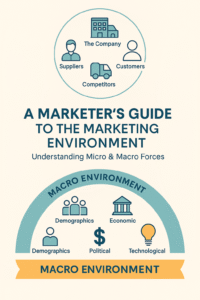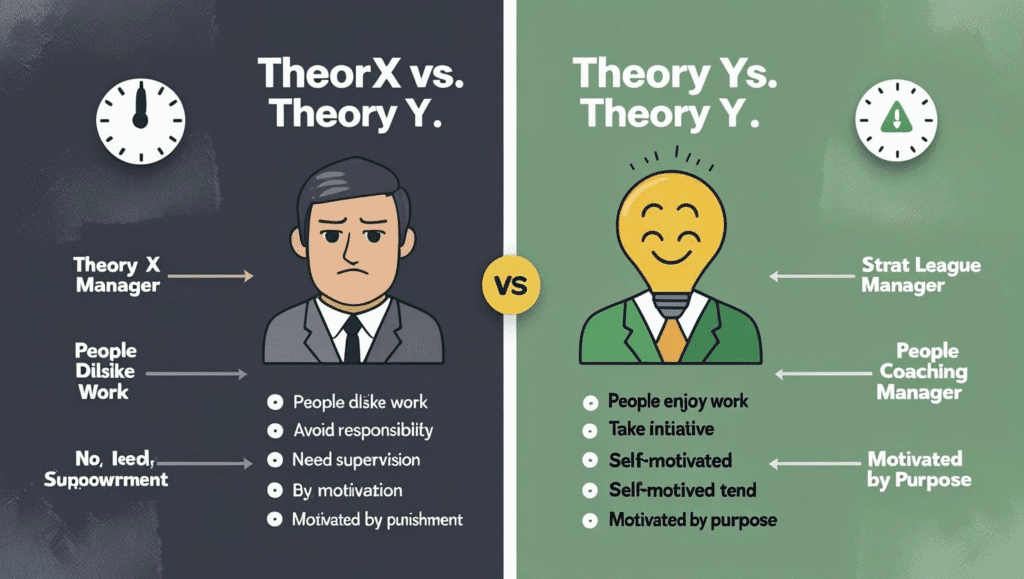A Marketer’s Guide to the Marketing Environment: Micro & Macro Forces
A company does not operate in a vacuum. It is surrounded by a complex and ever-changing environment. The Marketing Environment consists of all the internal and external actors and forces that influence a company’s ability to build and maintain successful relationships with its target customers. This environment is broken down into two key levels: the Microenvironment and the Macroenvironment.
The Microenvironment
The actors close to the company that directly affect its ability to serve its customers.
The Company
The internal environment. All departments—from finance and R&D to operations and HR—must work in harmony. A decision in one area (e.g., operations using cheaper parts) directly impacts the marketing promise of quality.
Suppliers
Provide the resources needed to produce goods and services. Supplier issues like price hikes, delays, or quality drops can damage customer satisfaction and harm the company’s reputation.
Intermediaries
Firms that help promote, sell, and distribute products to final buyers. This includes resellers (retailers), physical distribution firms, marketing agencies, and financial intermediaries.
Customers
The most crucial actors. Companies must analyze their different customer markets: Consumer, Business, Reseller, Government, and International markets, as each has unique needs.
Competitors
To succeed, a company must provide greater customer value than its competitors. This involves positioning its offerings strongly against competitors’ offerings in the minds of consumers.
Publics
Any group with an interest in or impact on an organization. This includes financial, media, government, citizen-action, local, and internal publics whose opinions can influence success.
The Macroenvironment
The larger societal forces that affect the entire microenvironment, often analyzed using the PESTLE framework.
-
Demographic Forces
The study of human populations, including age, gender, family structure, race, and geographic shifts. An aging population, for example, creates opportunities for healthcare and leisure industries.
-
Economic Forces
Factors affecting consumer purchasing power and spending patterns, such as inflation, interest rates, employment levels, and consumer confidence. An economic downturn might favor value-priced products.
-
Socio-Cultural Forces
The values, beliefs, and norms of a society. Trends like increased health consciousness, demand for convenience, and changing views on family directly shape product demand and marketing messages.
-
Technological Forces
The most dramatic force shaping markets. New technologies like AI, IoT, and mobile connectivity create new products and opportunities, while also making older products obsolete.
-
Ecological (Natural) Forces
The physical environment and natural resources. Growing concerns about climate change, resource scarcity, and pollution have led to increased demand for sustainable products and practices.
-
Political & Legal Forces
Laws, government agencies, and regulations that limit or influence business. This includes rules on competition, advertising standards, product safety, and data privacy (e.g., GDPR).
Frequently Asked Questions
What is the main difference between the micro and macro environment?
The Microenvironment consists of factors close to the company over which it has some degree of influence (e.g., suppliers, intermediaries). The Macroenvironment consists of larger societal forces that are generally uncontrollable but must be monitored and adapted to (e.g., economy, technology).
What is a PESTLE analysis?
PESTLE analysis is a strategic framework used to scan and analyze the key factors of the macro-marketing environment: Political, Economic, Socio-Cultural, Technological, Legal, and Environmental (or Ecological). It helps businesses understand the “big picture” forces shaping their market.
Why are suppliers considered part of the marketing environment?
Suppliers are a critical link in the company’s value delivery network. A delay in raw material delivery, a sudden price increase, or a drop in component quality directly impacts the company’s ability to deliver its promised value to the customer. Therefore, managing supplier relationships is a key marketing concern.


